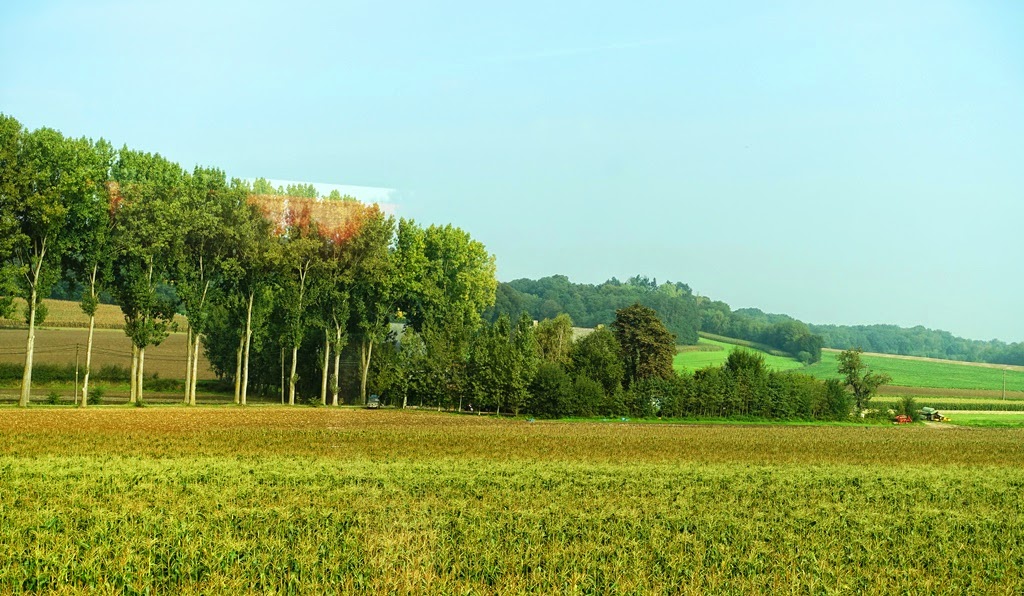The only time during our visit to Belgium that we left Flanders and ventured into the French-speaking Walloon region was when we made a day trip by train to the small (population: 13,600) riverside city of Dinant. The linguistic divisions that threaten to render Belgium apart are no more clearly illustrated than during our train ride: while the train was in Flanders, the announcements were all in Dutch; as soon as it crossed over into Walloon, they changed into French. The only area where the announcements were in both languages was in Brussels, which is officially bilingual:
The scenery from the train carriage window was pleasantly bucolic:
Upon arrival in Dinant:
Dinant's most impressive sight is the citadel, perched on the cliffs above the Église Notre-Dame church (which my daughter didn't want to visit after trauma she suffered inside Leuven's St-Pieterskerk). The fortress was first constructed in the 11th century, though the current edition is the result of an 1818-1821 rebuilding:
Dinant is also noted for being the birthplace and hometown of Adolphe Sax, inventor of the...well, you can figure out the rest:
Lunchtime, and time for a beer. The first one that day was a Leffe Blond, soon to become my wife's favorite Belgian brew (good thing, too, as she'd first developed an unhealthy fondness for Stella Artois):
Let's trout!:
Dining outdoors, overlooking the river Meuse, a person could get used to this kind of lifestyle:
A cable car was there to take us up to the citadel (it was even included in the admission price), but we opted to work off some of the beer we'd drunk by walking up the 400-plus steps to the top. We were rewarded with blue skies and great views:
The citadel was the sight of a bloody battle between invading German forces and defending French soldiers in the early days of the First World War, following the German invasion of neutral Belgium. Among the French wounded was a young lieutenant named Charles de Gaulle, who is remembered with a cartoonish-looking sculpture near the bridge on the opposite side of the Meuse. Following the retreat of the French forces, the Germans proceeded to slaughter 674 residents of Dinant, roughly 10% of the city's residents at the time. The victims included small children as young as two. It was the first of a number of atrocities the German military would commit on Belgian soil during World War I:
Looking down on the church of Notre-Dame:
There's a museum detailing the fighting inside the citadel, complete with realistic sounds of battle. This proved to be another traumatic experience for Amber, who was still shook up from having seen paintings of Christian saints being martyred earlier in our trip. If she should grow up to be nothing more than a peace-loving secular humanist, I will consider my efforts to be a good parent to have been successful:
Walking along the ridge of the citadel:
Next to the citadel is a cemetery filled with the graves of French soldiers who perished on Belgian soil during the Great War:
There are also the remains of about 25 or so Royal Canadian Air Force aviators who were shot down in December 1941 during the Second World War. The great contradiction of Europe is that such a beautiful continent has been the scene of so much bloodshed and devastation over the centuries. Here's hoping that the EU can leave all that in the past, where it belongs:
After taking a back-way down from the citadel and walking through the town, crossing the saxophone-lined bridge back across the Meuse:
We found the train service in Belgium to be efficient and reliable, though Jeff and Barbara begged to differ:
Back in Leuven, with its own memorial to those who perished in the supposed War to End All Wars (the citadel museum in Dinant had a great, though sadly sarcastic, exhibit listing all the wars that have occurred since the end of the First World War in 1918):
For dinner that evening, we did something different and ate at an Indian/Nepalese/Thai restaurant called Buddha House. The food wasn't bad, and neither was the Gorkha Beer, but it couldn't really compare to the amazing variety of suds that Belgium offers:




















No comments:
Post a Comment